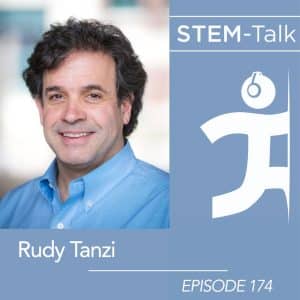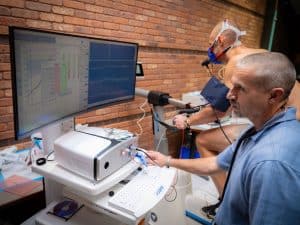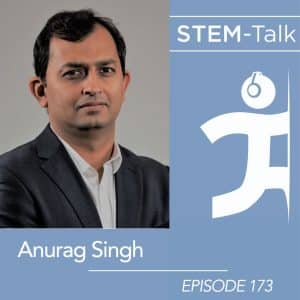STEM-Talk: Rudy Tanzi on genetics, aging, and the hallmarks of Alzheimer’s
Published 10.28.24
Dr. Rudy Tanzi is best known for co-discovering all three familial early onset Alzheimer’s genes — discoveries that have expanded what we know about the disease, how we might counter its effects, and the speed with which drug therapies can be brought to market.
He has co-written two books with Deepak Chopra, , “Super Brain” and “The Healing Self,” and is one of the top 50 most cited neuroscientists in the world. He also plays keyboards in the studio for Aerosmith and its guitar player Joe Perry.
A well-rounded career to be certain.
Tanzi is the director of the Genetics and Aging Research Unit as well as the director of the Henry and Allison McCance Center for Brain Health. He is also co-Director of the Massachusetts General Institute for Neurodegenerative Disease at Massachusetts General Hospital and serves as the Joseph P. and Rose F. Kennedy Professor of Neurology at Harvard Medical School.
He shares his expertise on this episode of STEM-Talk, available now wherever you listen to podcasts. It’s a fascinating conversation with someone who is a world-renowned expert in Alzheimer’s Disease.
“If you ask what leads to cognitive decline with age, or in a more serious way, what determines the degree of dementia once Alzheimer’s Disease begins, the answer is the same – the loss of synapses,” Tanzi says. “Inevitably as you age, synapses get lost. It’s our job to build synaptic reserves, like reserves in a bank, because the more synapses you make, the more you can lose before you get into trouble. The way you build synapses is simple: You learn new things.”
Listeners will learn many things in this episode including:
- How Tanzi’s childhood love of music — and a Jimmy Smith jazz album from his father — led from playing the accordion to playing the Hammond B3 organ. His father then asked if Tanzi would rather play the accordion or a Hammond B3 organ? “This is the same type of organ I was hearing in all the bands I was listening to like Yes and Sanatana and others. So, I said, yeah, I think I want to play the organ.”
- How his family’s medical transcription business fed his early science interest and led him to entering the Westinghouse Science Talent Search as a teen.
- How his project for the Westinghouse Science Talent Search on diabetic hypertensive retinopathy still influences his work today.
- His work with Jim Gusella in the early 1980’s at Mass General where they were the first group to discover a specific disease gene linked to Huntington’s disease.
- His discovery of the first Alzheimer’s gene, APP, which causes the production of amyloid and can cause a rare form of early onset Alzheimer’s.
- The lifestyle factors that play into whether someone who is predisposed to develop Alzheimer’s can stave off or completely avoid disease development. “Neuroinflammation is the biggest killer of nerve lines and synapses in the brain,” Tanzi says. “As we age, inflammation becomes more and more rampant throughout the body….Your lifestyle, the amount of sleep you get, the quality of your diet and exercise, all of these things affect the rate of neuroinflammation in your brain.”
IHMC is a not-for-profit research institute of the Florida University System where researchers pioneer science and technology aimed at leveraging and extending human capabilities. IHMC researchers and staff collaborate extensively with the government, industry and academia to help develop breakthrough technologies. IHMC research partners have included: DARPA, the National Science Foundation, NASA, Army, Navy, Air Force, National Institutes of Health, IBM, Microsoft, Honda, Boeing, Lockheed, and many others.
National Institutes of Health award for $7.7 million to determine how people over 60 attain the health benefits of exercise
Published 10.01.24
Dr. Marcas Bamman has received a $7.7 million award from the National Institutes of Health (NIH) for a clinical trial to determine how people age 60 and older attain the health benefits of exercise.
Bamman is a Senior Research Scientist at the Florida Institute for Human and Machine Cognition (IHMC) who leads the Institute’s Healthspan, Resilience, and Performance team.
This new project is called “Multidimensional Predictive Modeling to Understand Mechanisms of Exercise Response Heterogeneity in Older Adults.” It is a collaboration with the Oklahoma Medical Research Foundation and the University of Florida.
“This type of research is what the new Healthspan, Resilience, and Performance Research Complex was built to sustain,” says IHMC’s CEO and Founder, Dr. Ken Ford. “We anticipate that this research will foster significant advances in the understanding of the factors that impact the variability of response to exercise among older adults.”
Age-related functional declines are thought to be caused by hallmark biological processes that compromise healthspan and quality of life, says Bamman.
“Exercise is a potent treatment with promise to mitigate most aging hallmarks, but there is substantial variability in individual exercise responsiveness,” Bamman says. “This project will help us begin to understand what underlies those differences in responsiveness.”
The project will combine endurance and resistance training in alignment with public health guidelines to better understand variable exercise responsiveness in older adults with the goal of improving each older adult’s capacity to attain the many health benefits of exercise.
This inter-individual response heterogeneity was first identified in the context of endurance training and later was established with resistance training by current members of the IHMC team nearly 20 years ago. IHMC’s team has proposed the innovative, but logical, strategy to use combined endurance training and resistance training to maximize health benefits in aging adults.
Low cardiorespiratory fitness and low functional muscle quality are manifestations of the deterioration caused by cellular aging. Importantly, both conditions are modifiable with endurance training and resistance training.
The 2-phase trial, being managed by Senior Research Associate Craig Tuggle, will recruit up to 250 people ages 60 and up for a 23-week study period.
“We know that exercise is a bit of a miracle drug,” Tuggle says. “But we want to explore and better understand the variability in responses people have to it.”
Participants will be put on a protocol of endurance training and resistance training three days a week in Phase I. For Phase II, some will receive targeted augmentation (a boosted exercise prescription and free-living recommendations) while others will continue the Phase I endurance and resistance training protocol.
Recruitment of participants is likely to begin in late 2024 or early 2025.
IHMC is a not-for-profit research institute of the Florida University System where researchers pioneer science and technology aimed at leveraging and extending human capabilities. IHMC researchers and staff collaborate extensively with the government, industry and academia to help develop breakthrough technologies. IHMC research partners have included: DARPA, the National Science Foundation, NASA, Army, Navy, Air Force, National Institutes of Health, IBM, Microsoft, Honda, Boeing, Lockheed, and many others.
STEM-Talk: Anurag Singh on aging, exercise, and urolithin-A
Published 9.23.24
Dr. Anurag Singh has spent his career using research to unlock a better treatment path for the chronic diseases that dominated his early medical practice.
“I felt I was blindly treating the symptomology of these chronic diseases (cancer, diabetes), and it gave rise to the question, ‘What if we could intervene earlier?’” Singh says.
The journey to answer that question led him to Nestle Health Science and ultimately to his role as chief medical officer at Timeline Nutrition, a Swiss life-science company focused on improving mitochondrial and cellular health. Singh, who has a medical degree in internal medicine and a Ph.D. in immunology, is our guest for the latest episode of STEM-Talk, available now wherever you listen to podcasts.
Singh is known for his research into the gut metabolite urolithin-A, which has been shown to improve muscle quality, protect immune systems, and optimize mitochondrial efficiency. This compound is produced by gut bacteria from metabolizing ellagitannins and ellagic acid, which are found in foods such as pomegranates, red and black berries, walnuts, pecans — and even Iberian ham.
In this conversation, Singh shares how his desire to put “hard biology” at the root of nutritional approaches to healthspan is having groundbreaking impact. He shares:
- His belief that “exercise is a miracle drug. As a physician if I could prescribe it to most of the aging population I would. The problem with exercise is compliance.”
- How his family’s high expectations shaped his childhood. His youth spent in post-colonial India was one in which education was highly valued. “There was always a very clear focus of what I needed to achieve,” Singh says. “Being a doctor was sort of the ultimate prize in education.”
- How his work with Nestle Health Science opened the door to his current research interests.
- How this interest in doing a deep dive into the cellular and biological impacts of the health benefits of certain foods evolved to focus on mitochondrial health.
- How Singh’s research on urolithin-A led to the development of Mitopure, the first postbiotic nutrient that has been shown to trigger mitophagy by targeting cellular decline.
- Urolithin-A’s possible role in improving joint health and disease progression in osteoarthritis, cardiac tissue, brain aging and cognitive decline, fatty liver disease, insulin resistance, and more.
- What he thinks of as the five pillars of healthy aging: Exercise, diet, advanced nutrition, sleep, and stress management.
IHMC is a not-for-profit research institute of the Florida University System where researchers pioneer science and technology aimed at leveraging and extending human capabilities. IHMC researchers and staff collaborate extensively with the government, industry and academia to help develop breakthrough technologies. IHMC research partners have included: DARPA, the National Science Foundation, NASA, Army, Navy, Air Force, National Institutes of Health, IBM, Microsoft, Honda, Boeing, Lockheed, and many others.
STEM-Talk: Kevin Tracey on bioelectrical medicine and inflammation’s toll
Published: 9.5.24
Few people know as much about inflammation and neuroscience as Dr. Kevin Tracey does.
So how does he explain what inflammation — whose identification can be traced to the time of Galen — means to human health?
“Every year, 60 million people die on Earth,” he says. “Two-thirds of them — 40 million people — die of a disease caused or made worse by inflammation.”
That’s why he sees inflammation as “the single major threat to long healthspan because it contributes to the major killers and major unsolved diseases on the planet.”
In the latest episode of STEM-Talk, available now wherever you listen to podcasts, we learn much from Tracey, who was the first to identify the inflammatory reflex, a physiological mechanism that regulates the body’s immune response to injury and invasion.
He is a neurosurgeon, a pioneer in bioelectrical medicine and president and CEO of the Feinstein Institutes for Medical Research in Manhasset, N.Y.
The conversation in this episode covers a career spent working on “producing tomorrow’s cures today” in the treatment of inflammatory diseases, including:
- How the death of his mother from a brain tumor when Tracey was 5 years old ultimately influenced his scientific journey.
- How the death of a young patient of his from sepsis further fueled his path, leading him to the insight that “good science begins with hard questions,” as Tracey shared in a TedTalk.
- The molecular mechanisms of inflammation and the use of vagus nerve stimulation to treat it.
- His 1987 discovery of tumor necrosis factor (TNF), which contributed to a new class of drugs for inflammatory and autoimmune diseases.
- Another discovery that allowed him and his colleagues to merge neuroscience and immunology.
- His work on “The Inflammatory Reflex”, which emphasized the basic neural pathway that reflexively monitors and adjusts the inflammatory response.
- A sketch he drew while having lunch, which laid out how treating inflammatory diseases using a bioelectronic device might be possible.
- What advances in bioelectronic medicine he envisions in the next decade, and much more.
Tracey says he chose medical school because “I wanted my science to be in the context of inventing therapies. Making new drugs, making new treatments. To do that I needed to learn how disease works, how pathology works.”
IHMC is a not-for-profit research institute of the Florida University System where researchers pioneer science and technology aimed at leveraging and extending human capabilities. IHMC researchers and staff collaborate extensively with the government, industry and academia to help develop breakthrough technologies. IHMC research partners have included: DARPA, the National Science Foundation, NASA, Army, Navy, Air Force, National Institutes of Health, IBM, Microsoft, Honda, Boeing, Lockheed, and many others.
Evening Lectures focus on human performance, work culture and much more
Published: 9.3.24
The Evening Lecture series for Fall 2024 at Florida Institute for Human and Machine Cognition (IHMC) features a heavy focus on human performance, workplace culture and related topics.
The sessions begin in Pensacola on Sept. 19, 2024, with Sarah Robb O’Hagan, the chief executive officer of EXOS, a coaching company focused on human performance utilizing a team of fitness specialists, performance coaches, physical therapists, dietitians, and psychologists to maximize team performance.

Residents enjoy learning from scientific leaders at IHMC’s Evening Lectures. Photo Credit: William Howell/IHMC© all rights reserved.
She led the reinvention and turnaround of Gatorade as its global president, the digital transformation of Equinox Fitness Clubs as its President and the transformation of Flywheel Sports to a streaming content business as its CEO. She has held leadership positions at Nike and Virgin and is the author and founder of ExtremeYOU, a book and content platform.
Other Pensacola speakers include:
Oct. 17: Susan Paley, a CEO, founder, investor, and advisor who is focused on the intersection of entertainment, health and human performance. For more than 20 years she has worked with companies to set their strategic course, build their product roadmap, and guide sales and marketing. Throughout her career she has worked at the edges of new technology to see how it can be commercialized for deployment in market, and at scale.
Nov. 13: Dr. Tommy Wood, an Assistant Professor of Pediatrics and Neuroscience at the University of Washington and a Visiting Scientist at the IHMC is a UK-trained medical doctor with a Ph.D. in physiology and neuroscience. His research focuses on the physiological and metabolic responses to brain injury and how that impacts brain health across the lifespan. He is also interested in tracking health, performance, and longevity both in elite athletes and the general population. He sits on the scientific advisory board of Hintsa Performance, which includes developing nutrition and lifestyle strategies to optimize performance in Formula 1 drivers. He is a founding director of the British Society of Lifestyle Medicine.
In Ocala, speakers will include:
Sept. 12: Dr. Zach Graham, an IHMC Research Scientist whose research examines how exercise can be implemented to improve health and quality of life for people throughout life and across disease states. Spinal cord injury, Parkinson’s Disease and aging are a few of his areas of research interest, as well as research focused on muscle biology following spinal cord injury. Graham also is a health science research specialist with the Birmingham Veterans Administration Health Care System. His group looks to find novel molecular mechanisms and phenotypes that help guide individualized exercise prescriptions and more precise rehabilitation strategies.
Oct. 10: Dr. Dave Rabin, a board-certified psychiatrist, neuroscientist, entrepreneur, and inventor who has studied resilience and the impact of chronic stress on our lives for more than 15 years. In addition to focusing on integration therapy, plant and natural medicines, couples therapy, and medicine-assisted psychotherapy, Rabin specializes in treatment-resistant mental illnesses including depression, anxiety, post-traumatic stress disorder (PTSD), psychosomatic disorders, personality disorders, chronic pain disorders, insomnia, and substance use disorders using minimal and non-invasive treatment strategies.
Nov. 6: Dr. Todd Manini, a University of Florida professor and chief of clinical and population health integration at UF’s College of Medicine. He also serves as director of UF’s Claude D. Pepper Older Americans Independence Center. The center is funded under the National Institute on Aging and is dedicated to advancing both clinical and biological science for preserving physical independence for older Americans.
Dec. 10: Dr. Tim Broderick, IHMC’s Chief Science Officer and Senior Research Scientist. He helps shape research strategy and performs high impact research focused on enhancing human health and performance in extreme environments. Prior to joining IHMC he was an academic surgeon and Defense Advanced Research Projects Agency (DARPA) Program Manager. He has led multiple flight and undersea medical research projects. In addition to American Board of Surgery certification and fellowship in the American College of Surgeons, operational certifications and experience have prompted recognition as an Honorary NASA Flight Surgeon and NOAA undersea saturation diver.
Visit our website to stay up to date on future lectures in both Pensacola and Ocala.
IHMC is a not-for-profit research institute of the Florida University System where researchers pioneer science and technology aimed at leveraging and extending human capabilities. IHMC researchers and staff collaborate extensively with the government, industry and academia to help develop breakthrough technologies. IHMC research partners have included: DARPA, the National Science Foundation, NASA, Army, Navy, Air Force, National Institutes of Health, IBM, Microsoft, Honda, Boeing, Lockheed, and many others.
Science Saturdays schedule for Fall 2024 released
Published 8.22.24
Science Saturdays are back and ready to turn on new scientific minds this school year.
These 90-minute educational enrichment sessions are a cornerstone piece of community outreach at Florida Institute for Human and Machine Cognition (IHMC). Topics in 2024 will include 3D printing, bottle rockets, secret codes, and more. The sessions are free to the families who attend, thanks to the support of community partners.

Teresa Dos Santos and her team at Blu Salmon Design Firm teach Science Saturday attendees the science behind good design. Photo Credit IHMC © all rights reserved
For more than 17 years now, Science Saturday has inspired students in grades 3-7 in both Pensacola and on the Institute’s Ocala campus. In the 2023-2024 school year, more than 300 students attended the series, said Dr. Ursula Schwuttke, director of educational outreach for IHMC.
“Science Saturdays is so close to IHMC’s heart,” Schwuttke said. “It is one of our original outreach efforts and reflects the commitment we all feel to giving students of all ages and backgrounds the chance to fall in love with science and technology. We cannot wait to get started.”
Save these dates and visit this site for the latest: https://www.ihmc.us/life/science_saturdays/
Pensacola dates:
Sept. 21: Ozobots Programming, Heath Parr, Brown-Barge Middle School.
Oct. 26: Robot Hands, Dr. Gwen Bryan, IHMC.
Nov. 23 3-D Printing, Nicole Esposito, IHMC.
Dec. 14 Bottle Rockets, Jared Li, IHMC.
Ocala
Sept. 21: Paper Airplanes, Dr. Ian Perera, IHMC.
Oct. 12: Secret Codes, Dr. Arash Mahyari, IHMC.
Nov. 16: Animla Skull Detectives, Dr. Verity Mathis, Florida Museum of Natural History.
Dec. 7: Candy Chromatography, Dr. Manal Fakhoury, Clinical Pharmacologist.
Sponsors for the series in Pensacola include NextEra Energy Foundation/Florida Power & Light, Florida Blue Foundation, Cox, Alera Group, and the Escambia County Sherriff’s Office (with Law Enforcement Trust Fund monies).
Ocala supporters also include Lockheed Martin, Florida Blue Foundation, Cox, Precision Sidewalk Safety and Ocala Electric Utility.
IHMC is a not-for-profit research institute of the Florida University System where researchers pioneer science and technology aimed at leveraging and extending human capabilities. IHMC researchers and staff collaborate extensively with the government, industry, and academia to conduct ground-breaking science and develop breakthrough technologies. IHMC research partners have included: DARPA, the National Science Foundation, NASA, Army, Navy, Air Force, National Institutes of Health, IBM, Microsoft, Honda, Boeing, Lockheed, and many others.
STEM-Talk: Ken takes listeners questions for an Ask Me Anything episode
Published 8.9.24
Is AI at its peak or is it just getting warmed up?
That’s just one of the questions Dr. Ken Ford, IHMC’s CEO and Founder weighs in on in this “Ask Me Anything” episode of STEM-Talk available now wherever you listen to podcasts.
In this episode, Ken, who is Fellow of the Association for the Advancement of Artificial Intelligence, shares his thoughts on AI given the recent developments in the field, particular in the realm of Generative AI, with programs like Chat GPT becoming a household name in the last year.
“(Large Language Models) as they have been developed can be thought of as memorization machines. When you think of them in this way, scale is everything from this perspective,” Ken says. “I would argue that intelligence is more than memory and recall. Artificial General Intelligence (AGI) may now be the goal, thinking as a human would. But much of the advance that we have seen in recent years is due to scale increasing, not really due to algorithmic advances.”
Listeners will also learn in this episode which science-fiction author is Ken’s favorite — and which quote from this person he still inspires him.
Other queries in this episode include:
- The FDA’s recent approval of a neural implant device which is touted as a means of allowing people with degenerative neuromuscular disease, or spinal cord injuries, to interface with external technology via neural signals.
- A recently published study titled “APOE 4 Homozygosity Represents a Distinct Genetic Form of Alzheimer’s Disease,” which could leave the impression that those with two copies of the APOE 4 gene are certain to develop the disease with nothing to be done to prevent it.
- Why more gyms and physical therapy centers don’t make blood flow restriction devices available for their clientele, given that studies have shown that BFR improves strength and muscle mass in both young and older adults.
- How our physical fitness regimen should change as we age and the best balance of resistance, cardio, and high intensity interval training bearing in mind an increasing risk for injury.
- And much, much more.
IHMC is a not-for-profit research institute of the Florida University System where researchers pioneer science and technology aimed at leveraging and extending human capabilities. IHMC researchers and staff collaborate extensively with the government, industry and academia to help develop breakthrough technologies. IHMC research partners have included: DARPA, the National Science Foundation, NASA, Army, Navy, Air Force, National Institutes of Health, IBM, Microsoft, Honda, Boeing, Lockheed, and many others.
Air Force Academy’s Cadet Summer Research Program interns find home at IHMC
Published 7.26.24
Students have long had a home at the Florida Institute for Human and Machine Cognition.

U.S. Air Force Academy Cadets Katherine Judy, Connor Manion, and Weiss O’Connor discuss findings from their data analysis on the AFOSR ROPER project with IHMC Researcher Dr. Kevin Gluck. Photo Credit: IHMC
This summer’s student collaborators included cadets from the U.S. Air Force Academy participating in the Cadet Summer Research Program. This program offers opportunities for cadets to get out of the classroom and experience real-world research and development that align with their majors, interests, and potentially their career fields.
Senior Research Scientist Dr. Kevin Gluck, who worked with the students, says that although they won’t all pursue science or engineering in the Air Force, it is certain research and development will play a role in all their careers.
“Their experiences at IHMC this summer established a foundation they will build on in their senior capstone project, and they will carry those lessons about rigorous scientific processes and advanced methodologies forward with them as new officers and emerging leaders within the Air Force,” Gluck says.
All the cadets are majoring in Systems Engineering with a Human Factors focus. They are working on a project funded by a three-year grant from the Air Force Office of Scientific Research whose goal is to improve scientific understanding of the biological, physiological, and cognitive variations in people in response to nutritional stress, sleep stress, and physical stress.
The cadets are working on retrospective modeling, simulation, and analysis on data sets from previous studies in which those stressors were factors in changes in performance over days or even weeks. Research Scientist Dr. Drew Cranford worked closely with the cadets and praised their work — and their work ethic.
The students got a crash course on how to create and run cognitive models within a cognitive architecture, then they learned how to optimize parameters of the model to predict individual performance as stress varied over the course of the study, Cranford says.
They focused on changes in cognitive performance because of sleep stress. They also are evaluating the validity of computational theories against the human performance data. They have reviewed data including the results of a psychomotor vigilance tests and a second cognitive assessment of working memory.
“This initial focus will provide a foundation for their senior capstone project as we extend the methods to model individual performance heterogeneity in stress response across multiple tasks including attention, visual vigilance, working memory, and reasoning/decision making tasks, and other studies that involve different kinds of stressors,” Cranford says.
“They have surely impressed with their desire to learn and enthusiastic work ethic.”
Intern Weiss O’Connor says he was surprised to learn the detrimental, cumulative effects of sleep deprivation on people.
“Before this project, I assumed that long-term sleep deprivation could have some negative effects, but that humans could eventually adapt to those conditions,” O’Connor says. “With some context from biomathematical models, I’ve seen how detrimental effects continue to progress with sustained deprivation.”
Cadet Kate Judy was intrigued by the use of computational modeling to improve understanding of human performance, as well as the application of this project to real-life, defense-related projects.
“I have not stopped learning since I got here, but the idea of using computers to model and help further study the human brain is simply not something I was familiar with up until now,” Judy says. “I know I have just barely scratched the surface in the first five weeks, and I am excited to continue learning as we progress through our capstone project.”
Critical to the success of the grant and the summer research program is for the students to bite off a substantive but manageable chunk of work to pursue.
Connor Manion, like the others, says the Cadet Research program is a tremendous educational asset that offers students the chance to gain valuable skills.
Manion says stress and fatigue are frequent topics of discussion at the Air Force Academy. IHMC has given Manion the opportunity to learn more about both in a scientifically meaningful way.
While the intellectual aspects of the research program have been valuable, Manion says there have been other benefits.
“The most surprising thing that I have learned is how it is possible to enter a new environment and build a life that suits the way I want to live,” Manion says. “The routine at IHMC has given me the opportunity to explore how it will be showing up to my first assignment or subsequent assignments as I go into my career in the operational Air Force. I believe this facet of my Cadet Research Program trip will have the most profound impact on my life.”
IHMC is a not-for-profit research institute of the Florida University System where researchers pioneer science and technology aimed at leveraging and extending human capabilities. IHMC researchers and staff collaborate extensively with the government, industry and academia to help develop breakthrough technologies. IHMC research partners have included: DARPA, the National Science Foundation, NASA, Army, Navy, Air Force, National Institutes of Health, IBM, Microsoft, Honda, Boeing, Lockheed, and many others.
STEM-Talk: Charles Serhan, expert on specialized pro-resolving mediators, talks inflammation
Published 7.22.24
For Dr. Charles Serhan, music was one of the keys that unlocked his love of science. Serhan counts among his many talents, being an accomplished vibraphone player.
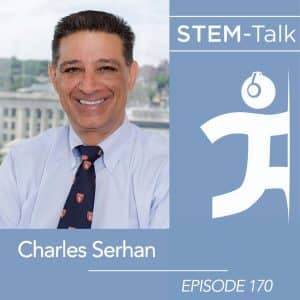
“Many things I learned in music translated to science,” Serhan said. “If you really wanted to play well, you had to study and practice. It’s like learning a language. In science the same is true. You need to learn the language and study and practice every day.”
Why does he love science?
“The rigor and objectivity and the ability to test hypothesis an experiment,” he says. “Nothing is more fun than that.”
Serhan is our guest on the latest episode of STEM-Talk, available now. He is a Harvard professor who discovered specialized pro-resolving mediators, also known as SPMs, which help promote the natural end of the inflammation process and allow a person to avoid anti-inflammatory drugs.
Inflammation is believed to be a contributing factor to metabolic and chronic diseases across a wide spectrum including diabetes, cardiovascular disease, Alzheimer’s disease, asthma, arthritis, and more. Understanding its roots — and the role that SPMs play in switching off the process — is considered a key component to improving healthspan and resilience.
This edition of STEM-Talk features co-host Dr. David LeMay, who appeared on Episode 69 of STEM-Talk back in 2018. LeMay is a sports medicine and rehabilitation physician who has been a consultant for the NBA’s Washington Wizards, the NFL’s Oakland Raiders and the National Hockey League’s Washington Capitals. He is a Visiting Research Scientist at IHMC who is board certified in physical medicine and rehabilitation, he is board certified in metabolic and nutrition medicine, and has completed a fellowship in anti-aging and regenerative medicine. He is an associate clinical faculty member at Florida State University.
Tune in to their conversation today on your favorite podcast platform.
IHMC is a not-for-profit research institute of the Florida University System where researchers pioneer science and technology aimed at leveraging and extending human capabilities. IHMC researchers and staff collaborate extensively with the government, industry and academia to help develop breakthrough technologies. IHMC research partners have included: DARPA, the National Science Foundation, NASA, Army, Navy, Air Force, National Institutes of Health, IBM, Microsoft, Honda, Boeing, Lockheed, and many others.
IHMC partners with California-based research institute to take aim at the psychology of cyberattackers
Published 7.2.24
The battle against cyberattackers has often felt like an uphill slog. The Florida Institute for Human and Machine Cognition (IHMC) is part of a team looking to turn that tide.
This spring, IHMC partnered with California-based nonprofit research institute SRI to take aim at the psychology of cyberattackers to better defend against their efforts.

Research Scientist Dr. Brodie Mather.
The project is funded by Intelligence Advanced Research Projects Activity (IARPA) — the research and development arm of the Office of the Director of National Intelligence — which launched it in February 2024. DNI refers to the project as Reimagining Security with Cyberpsychology-Informed Network Defenses (ReSCIND)
SRI is one of five organizations IARPA has contracted with for the effort. As part of SRI’s team, IHMC is involved in all aspects of the research, but its unique contribution is the human subjects research expertise Senior Research Scientist Dr. Anil Raj and Research Scientist Dr. Brodie Mather and their IHMC team bring to the project.
The goal is to use psychology-informed defenses to understand cognitive vulnerabilities of an attacker individually and tailor the defenses to the vulnerabilities of that attacker.
“The ultimate goal of the program is reclaim agency in the battle against cyber attacks,” Mather said. “It has felt like a bit of a losing battle, fighting off these attacks for organizations of all sizes. We hope this could be a way for organizations to reclaim some of their time and agency in defending against these attacks.”
Cyber attackers typically take advantage of human errors, but most cyber defenses do not similarly exploit attackers’ cognitive weaknesses. The ReSCIND project aims to flip this script.
By combining traditional cybersecurity practices with cyberpsychology expertise, IARPA is set to engineer a first-of-its-kind technology that makes an attacker’s job harder.
SRI noted in its news release that the technology at the heart of this project could be revolutionary in the field, by measuring, understanding, and exploiting cognitive vulnerabilities to prevent cyber attackers from achieving their goals effectively and efficiently.
The four-year project is multi-phased, with five major technical challenges that IHMC will helped lead the work in. That work began this spring and phase one is expected to take approximately 18 months.
IHMC is a not-for-profit research institute of the Florida University System where researchers pioneer science and technology aimed at leveraging and extending human capabilities. IHMC researchers and staff collaborate extensively with the government, industry and academia to help develop breakthrough technologies. IHMC research partners have included: DARPA, the National Science Foundation, NASA, Army, Navy, Air Force, National Institutes of Health, IBM, Microsoft, Honda, Boeing, Lockheed, and many others.
STEM-Talk: Dave Feldman on the Citizen Science Foundation, ketogenic diet research
Published 6.21.24
How did the son of two Bohemian graphic designers become a citizen science advocate who built his knowledge to turn his own health around?
It’s a journey worth listening to, and in this episode of STEM-Talk, Dave Feldman shares that story. The episode is available now wherever you listen to podcasts.
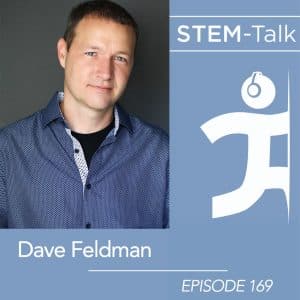
Dave Feldman appears on STEM-Talk Episode 169.
Feldman is the founder of the Citizen Science Foundation and is known for his research into the ketogenic diet. Dave is a software engineer by training who embraced a ketogenic diet to avoid his progression toward type 2 diabetes.
After undertaking the high-fat/low-carbohydrate diet, Dave’ LDL cholesterol spiked. Dave’s experience as an engineer provided an unusual conceptual framework as he immersed himself in learning everything he could about cholesterol and lipids. What he learned led him to create the website Cholesterol Code, a research hub for information and emerging data on cholesterol, particularly in the context of a low-carbohydrate lifestyle.
The Citizen Science Foundation is designed to support projects and research that promote collaborative efforts across multiple disciplines, both in and outside formal scientific institutions.
The conversation covers a lot of ground, including:
- How self-directed learning became a theme of Dave’s life, beginning in his youth in the 1980s.
- How the idea of being a “lean mass hyper-responder” came into Dave’s vernacular, what that phenotype means, and the research surrounding it.
- Dave’s 2022 paper on the Lipid Energy Model, titled: “Lipid Energy Model: Reimagining Lipoprotein Function in the Context of Carbohydrate Restricted Diets,” asking him to expound on the concept and its significance.
- The challenges Dave has faced in his journey to self-fund research through crowdfunding, for which he founded a 501c3 non-for-profit, which in 2019 was named the Citizen Science Foundation.
IHMC is a not-for-profit research institute of the Florida University System where researchers pioneer science and technology aimed at leveraging and extending human capabilities. IHMC researchers and staff collaborate extensively with the government, industry and academia to help develop breakthrough technologies. IHMC research partners have included: DARPA, the National Science Foundation, NASA, Army, Navy, Air Force, National Institutes of Health, IBM, Microsoft, Honda, Boeing, Lockheed, and many others.
New biomedical research complex opens IHMC’s next chapter
Published 6.11.24
The new $40 million biomedical research complex constructed by the Florida Institute for Human and Machine Cognition (IHMC) will be more than a striking addition to the Pensacola skyline.
It will be an accelerant for the pace of discovery that will drive innovations in maximizing the healthspan for everyone from elite military operators and veterans to those with neurodegenerative diseases, musculoskeletal problems, and chronic metabolic conditions.
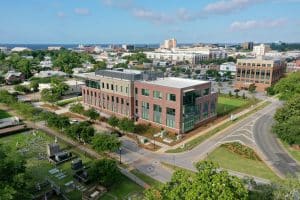
IHMC’s new $40 healthspan, resilience, and performance research complex.
The Healthspan, Resilience and Performance Research Complex is another step in the evolution of the vision that has been the bedrock of IHMC since its founding by Dr. Ken Ford, the Institute’s Chief Executive Officer.
“Pushing the boundaries of science to maximize the performance and resilience of human beings has long been a foundational tenet at IHMC,” Ford says. “In our healthspan, resilience and performance research thrust, the vision has always been to work from the molecular level to the whole human. This facility brings that to life.”
Dr. Morley Stone, Chief Strategic Partnership Officer, notes that the leading-edge research complex gives IHMC’s interdisciplinary team of researchers the ability to truly realize that vision.
“The healthcare system as it is set up now puts people on a trajectory to decline over decades,” Stone says. “We want to lead the science that drives people to extend the period of a person’s life over which they are high functioning and healthy.”
The unique facility puts Pensacola and Northwest Florida at the center of a human and biological sciences economic ecosystem that did not exist before this $40 million research facility came out of the ground. It also serves as a draw for top research talent to the area from all over the world.
“The ability to move from whole human physiology and performance to the molecular level in one facility — there’s nothing else like it in the southeast that I can think of,” Stone said.
The Healthspan, Resilience, and Performance Research Complex will be an economic and intellectual beacon for the entire Northwest Florida region, says Dr. Marcas Bamman, Senior Research Scientist and Director of Healthspan, Resilience, and Performance research at IHMC.
The science conducted here will be an economic engine, drawing in new funding in federal and industry-sponsored research. Partners in the project have included Space Florida and Triumph Gulf Coast, the nonprofit corporation funded by a legal settlement with British Petroleum following the 2010 Deepwater Horizon oil spill. Funding provided by these agencies helped seed and support the complex.
The Healthspan, Resilience, and Performance Research Complex stands apart among biomedical science hubs due to the collaborative, cross-discipline spirit that has been a hallmark of IHMC since its beginning. Researchers working in the new research complex are literally an arm’s length reach away from experts in AI, cognitive psychology, computational modeling, data visualization, exoskeletons, engineering and more.
“It’s an accelerant for the speed of discovery,” Stone says.
The three-story, 40,000 square foot facility was built by Brasfield & Gorrie and designed by DAG Architects partnered with Atlanta-headquartered Cooper Carry. The complex is literally designed to fuel the pace of discovery. The first floor is built around human participant testing and intervention, featuring rehabilitation facilities, biomedical sampling tools and performance testing laboratories.
“The first floor focuses on clinical and applied science,” Bamman says. “The third floor contains leading-edge wet laboratories for cellular and molecular science, which enable us to extend and better understand the effects we are having on people on the first floor. We now have the unique capacity – leveraging a range of scientists and technology – to deeply study and improve strategies that enhance healthspan, resilience, and performance for all.”
As the biological sciences have become intertwined with information and computer sciences, IHMC is uniquely positioned to accelerate that trend — and excel while doing it, Stone says.
“Every institution that’s doing this work is struggling with how to generate meaning from that information,” Stone says. “Going back to our legacy, being able to tap into artificial intelligence and machine learning capability that was the foundation of IHMC is an invaluable resource for being able to make meaning out of that information that’s generated.”
A regional economic hub, a draw of international experts
The new Healthspan, Resilience, and Performance Research Complex is not just a magnet for talent. It is a magnet for dollars that come into the community that do more than recirculate around the community.
“In this case, we’re bringing in millions of dollars of new research money into the economy that our researchers use to buy houses, eat at restaurants, and buy cars. That type of impact is hard to match,” Stone says.
While the population at large ultimately will benefit from what IHMC researchers learn about aging, degenerative and chronic metabolic conditions and what interventions might help ameliorate these, military operators are a specific target audience of the research done at IHMC.
“And frankly,” Stone notes, “it’s just part of the moral obligation that we have to our service members to make sure that not only they leave in the best possible shape they can, but the years after they leave are as productive and high functioning as possible. That’s the moral obligation.”
It’s one that thanks to the Healthspan, Resilience, and Performance Research Complex, IHMC uniquely is positioned to fulfill.
IHMC is a not-for-profit research institute of the Florida University System where researchers pioneer science and technology aimed at leveraging and extending human capabilities. IHMC researchers and staff collaborate extensively with the government, industry and academia to help develop breakthrough technologies. IHMC research partners have included: DARPA, the National Science Foundation, NASA, Army, Navy, Air Force, National Institutes of Health, IBM, Microsoft, Honda, Boeing, Lockheed, and many others.
Triumph Gulf Coast funding will help bolster research capabilities at Pensacola campus
Published 5.30.24
An investment of $7.8 million from Triumph Gulf Coast will allow IHMC to bolster its research capabilities with a facility designed to handle sensitive federal research in support of Department of Defense and intelligence community customers.
The grant to the Florida Institute for Human and Machine Cognition was approved by Triumph’s board of directors in December 2023. Previous Triumph funding helped seed the $40 million Healthspan, Resilience, and Performance (HRP) research complex now under construction. The story is featured in the latest edition of IHMC’s newsletter, which is available now.
The award includes funding to construct a highly flexible, multilevel secure facility. The addition of secure capabilities will bolster the institute’s ability to meet federal grant and contract security requirements. Dr. Morley Stone, IHMC’s Chief Strategic Partnership Officer, says such a facility allows the Institute “to work at a deeper level with key research sponsors and better address their needs.”
Absent the facility, Stone said, travel is required for discussions with some defense-related research sponsors. “Having those discussions locally, and by having the sponsor interact with our researchers and see our facilities, that often leads to more sponsored work.”
David Bear, chairman of the Triumph Board of Directors, says the secure facility is the type of project the board likes to support. Triumph is the nonprofit corporation funded by a legal settlement with BP following the 2010 Deepwater Horizon oil spill.
“IHMC continues to build on the success of its Healthspan, Resilience, and Performance program,” Bear says. The addition of secure facility capabilities expands IHMC’s ability to bring economically impactful research opportunities to the region far beyond the term of this grant, continually improving and diversifying our economy.”
The grant will provide a much-needed secure environment for sensitive federal activities related to requirements stemming from national defense, intelligence, and security sponsors. It also will facilitate collaboration with government agencies, defense contractors, and other research organizations involved in research which demands the greatest protections.
“The incorporation of secure facilities and secure processing capabilities within our new facility will fortify our research capabilities, increase research opportunities, and establish IHMC as a regional leader in research advancements for Government sponsors requiring these highly specialized assets.”said Ryan Tilley, IHMC’s director of strategic program execution and innovation.
The grant also includes funding for additional equipment related to the HRP research that will be housed at the new complex at the corner of Garden and Alcaniz streets.
“Over the course of our work on this project, and as research technology advances, we have identified the need for additional specialized equipment that will significantly contribute to the quality and depth of our research efforts. We are proud that Triumph sees IHMC as a leader in this effort and we are grateful for their support,” Tilley said.
The HRP complex will be a one-of-kind facility for healthspan, resilience, and performance research that also bolsters the regional economy through new funding in federal and industry-sponsored research. The complex will become a hub for collaboration with regional institutions and organizations that share an interest in healthspan and performance.
IHMC is a not-for-profit research institute of the Florida University System where researchers pioneer science and technology aimed at leveraging and extending human capabilities. IHMC researchers and staff collaborate extensively with the government, industry and academia to help develop breakthrough technologies. IHMC research partners have included: DARPA, the National Science Foundation, NASA, Army, Navy, Air Force, National Institutes of Health, IBM, Microsoft, Honda, Boeing, Lockheed, and many others.
IHMC Robert Griffin represents the America on IEEE Technical Committee
Published 5.23.24
Dr. Robert Griffin has been named co-chairman of the IEEE Robotics and Automation Society Technical Committee on Humanoid Robots, representing the Americas.

IHMC Research Scientist Dr. Robert Griffin
The Institute of Electrical and Electronics Engineers (IEEE) is the premier professional organization in the field. Griffin’s selection to co-chair the technical committee reflects the high regard for his work and for IHMC’s leadership in the field of humanoid robotics.
“IHMC has been a pioneer in the field of humanoid robotics. Robert’s selection to the IEEE RAS Technical Committee is a much-deserved accolade for him and for the team at IHMC,” said Dr. Ken Ford, IHMC’s founder and chief executive officer.
The Society’s Technical Committee, among other things, leads the annual Conference on Humanoid Robots, the leading international event of the humanoid robotics community. Last year, the conference was hosted in Austin, Texas. Previous locations have included Okinawa, Japan, and Munich, Germany.
The IEEE-RAS includes the flagship conferences of the robotics field, International Conference on Intelligent Robots and Systems (IROS) and International Conference on Robotics and Automation (ICRA), each of which see more than 5,000 attendees annually.
The robotics team at IHMC has often been lauded at the conference for their work. In 2016, 2019, and 2022, the team won Best Paper accolades at the conference. The most recent winning paper “A Fast, Autonomous Bipedal Walking Behavior Over Rapid Regions,” focused on a newly constructed behavior control system for smooth walking over rough, unbalanced terrain.
“To be appointed as a co-chair to represent the Americas is a great honor. I am excited to work alongside the other co-chairs, whose work and impact on the field of humanoid robots cannot be overstated,” Griffin said. “To be counted among their ranks is an incredible recognition that I am deeply humbled by.”
“This recognition is only possible because of the incredible team at IHMC, whose tireless effort and talents cannot be understated. It’s an exciting time to be working on humanoid robots, and I look forward to seeing what the future in this field brings,” Griffin said.
IHMC is a not-for-profit research institute of the Florida University System where researchers pioneer science and technology aimed at leveraging and extending human capabilities. IHMC researchers and staff collaborate extensively with the government, industry and academia to help develop breakthrough technologies. IHMC research partners have included: DARPA, the National Science Foundation, NASA, Army, Navy, Air Force, National Institutes of Health, IBM, Microsoft, Honda, Boeing, Lockheed, and many others.
STEM-Talk: Alessio Fasano on the roots of, treatments for celiac disease
Published 5.22.24
Dr. Alessio Fasano, who is considered the world’s leading expert in celiac disease and gluten-related disorders, returns for his second appearance on STEM-Talk. The interview is available now where you listen to podcasts.

Dr. Alessio Fasano makes his second appearance on STEM-Talk.
As he tells co-hosts Dr. Ken Ford and Dr. Marcas Bamman, he went to medical school with the idea of changing the world. And pediatrics, for him, was a love-at-first-sight way to accomplish this lofty goal.
“I realized from the very beginning in medical school that dealing with kids was going to be more fun and interesting,” Fasano says.
When it came time to choose a mentor, he chose someone who had come back from the University of Chicago, where he’d studied diarrheal diseases.
“I thought that was unglamorous. I wanted to save the world and study cancer or HIV. He educated me. He said that every year 5 million kids would die of diarrheal disease, so if I wanted to do something impactful, I should focus on that.”
Ever since, Fasano has been doing work that could have a profound impact of the health and well-being of people. He is director of the Mucosal Immunology and Biology Research Center at Massachusetts General Hospital. In addition to celiac disease and gluten-related disorders, his research is also focused on the microbiome, intestinal permeability and autoimmune disorders, which he discussed in his first interview on STEM-Talk, episode 20.
Since Alessio’s first appearance on STEM-Talk in 2016, he has published two books, “Gluten Freedom” and “Gut Feelings: The Microbiome and Our Health,” which we discuss in today’s interview.
Also in this episode we talk about:
- Fasano’s new project to bring together an international consortium of researchers and scientists for a long-term study that will follow infants who are genetically at risk of developing celiac disease.
- His early career working on cholera, where he discovered the zonula occuldens toxin, the bacteria that causes cholera.
- How the discovery of zonulin, which is the molecule that modulates gut permeability in humans, led Fasano to investigate celiac disease, which is triggered by gluten.
- Why the medical community, historically, has not taken celiac disease seriously. Although just 2 million Americans have celiac disease, an estimated 20 million Americans suffer from gluten sensitivity.
- The progress being made to develop pharmacological interventions for celiac and much more.
IHMC is a not-for-profit research institute of the Florida University System where researchers pioneer science and technology aimed at leveraging and extending human capabilities. IHMC researchers and staff collaborate extensively with the government, industry and academia to help develop breakthrough technologies. IHMC research partners have included: DARPA, the National Science Foundation, NASA, Army, Navy, Air Force, National Institutes of Health, IBM, Microsoft, Honda, Boeing, Lockheed, and many others.
IHMC hosts the IGNITE event for the NATO Innovation Continuum
Published 5.21.24
Recently, IHMC hosted an international group of experts tasked with innovation and experimentation in the capabilities for members of the North Atlantic Treaty Organization (NATO).
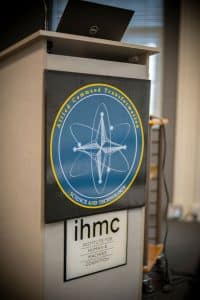
In May 2024, IHMC hosted the IGNITE event for the NATO Innovation Continuum.
In February 2024, NATO’s Allied Command Transformation launched the Innovation Continuum 2024 series with an event in La Spezia, Italy. From that first event, named Spark, came an initial list of operational scenarios and possible technical solutions to be explored further.
The Ignite event was the second event in the series. Senior Research Scientist and Associate Director Dr. Niranjan Suri was the host of the Ignite event. Throughout his career, Suri’s research has focused on networking, communications, distributed systems, information management, interoperability, the Internet of Things, and the application of machine learning to all of these domains.
“It was a pleasure to host NATO Allied Command Transformation, NATO Communications and Information Agency, NATO Center for Maritime Research and Experimentation, many national representatives, as well as many prominent companies, including IBM, Microsoft, and Amazon Web Services, here in Pensacola,” Suri said. “We spent four days planning for the experimentation that will take place in the fall.”
Since 2014, Suri has co-chaired a NATO coalition of experts and thought leaders looking at military domains with an eye toward how civilian IoT data could be made available to warfighters on humanitarian or military missions.
The Innovation Continuum is a strategic initiative by Allied Command Transformation to use experimentation and demonstration of cutting-edge science and technology solutions to drive innovation and enhance warfare development through collaboration among NATO enterprise bodies and nations. The events are named Spark, Ignite, Glow, and Shine.
Ignite brought together military professionals, industry leaders, academia representatives, and subject matter experts in the fields of emerging and disruptive technologies. It included deep discussions and practical exercises aimed at operationalizing concepts developed during Spark.
As the Continuum unfolds, Ignite will serves as a catalyst for translating innovative ideas into concrete solutions for NATO to harness the power of technology to safeguard its collective security.
“Activities such as the Innovation Continuum are essential to rapidly take new and emerging technologies, consider how we might use them in the context of NATO, and evaluate these concepts in experiments,” Suri said.
IHMC is a not-for-profit research institute of the Florida University System where researchers pioneer science and technology aimed at leveraging and extending human capabilities. IHMC researchers and staff collaborate extensively with the government, industry and academia to help develop breakthrough technologies. IHMC research partners have included: DARPA, the National Science Foundation, NASA, Army, Navy, Air Force, National Institutes of Health, IBM, Microsoft, Honda, Boeing, Lockheed, and many others.
IHMC researcher using cognitive science, novel language understanding methods to harness AI’s power
Published 5.16.24
Dr. Ian Perera started his research career by exploring the question of whether computers could become more intelligent and helpful assistants by learning the way children do.
If the IHMC Research Scientist can make it work, the implications could be wide-ranging and substantial.
Since joining IHMC in 2013, Perera has worked on numerous military and government projects using novel language understanding methods and cognitive science on problems from de-escalating heated social media conversations to improving trust between human and AI team members and more. His work is featured in the latest edition of the IHMC newsletter, available now.
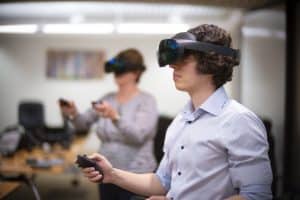
Research Scientist Dr. Ian Perera’s work at IHMC’s Ocala campus includes artificial intelligence, cognitive science and more.
The popular culture’s focus on headlines claiming AI can perform complicated tasks and will soon replace our workforce misses something critical, Perera says.
“This technology is uncritically learning associations between words and concepts, and mimicking behaviors of people online that isn’t always grounded in reality,” Perera says.
While there is some similarity to the powerful associative learning connections that children use when they encounter something new, imbuing AI with a more critical and exploratory approach could lead to a powerful capability with a transformative influence on human decision-making.
It could benefit warfighters in the heat of battle, cool the overheated world of social media commentary, and even improve the long-term health and well-being of military personnel.
While artificial intelligence has a fever-grip on the public imagination, Perera has delved into the true possibilities and limitations of this discipline. And here’s a hint: It’s not about supplanting human intellect.
“The goal is to take our knowledge about how we learn things and use it to inform our models so that they get a better understanding more quickly,” Perera said. “We are looking at strategies to augment associative learning that could be translated to artificial intelligence.”
Typical AI training involves a massive data dump into the system to “teach it,” but that creates an AI that is only as trustworthy as the data it has been fed. Perera has worked to find ways to use language to teach machine learning systems and minimize flaws such as implicit bias.
Having trust in an AI-teammate’s decision is critical to the successful integration of the technology into human decision-making, especially for military operators and others who could rely upon such data to make life-or-death decisions.
“What we were looking at is, can we make sure that an explanation is encoded into the system so that when it makes a decision, you can see if it seems like a logical consequence of what the system is deciding,” Perera says.
Perera’s current work includes a project for the U.S. Navy where AI is responsible not only for finding irregularities or unexpected events, but also for providing the user with multiple possible explanations given the context. For example, multiple ships may be stationary nearby because they are waiting out a storm, or aspects of their behavior may point to illicit activity.
The applications are wider ranging than warfighting, however.
One such project, Civil Sanctuary, had the goal of engaging in social media communities with automated dialogue agents to help with content moderation.
And if there is any place where there is room for improvement, it is the world of online discourse.
Civil Sanctuary aimed to spot language that would indicate when people in an online forum are crossing the line from disagreeing to becoming toxic.
“We wanted to see if we could say something about the emotions being conveyed or the moral foundation” of the comments, Perera said.
Keeping a human in the loop of content moderation is ideal, but the volume of content to moderate makes it nearly impossible for humans to keep up. AI could be helpful in this, especially if it can sense the tone and emotional meaning beneath the words.
Perera’s modeling took several things into account to try to gauge when a moderator gets involved in the interplay among commentors. He also worked on modeling how the community responds to certain emotions.
“We can pick up on it before the human would and before it can do more damage, and say to the human in the loop, ‘Hey, this may be something you want to look at,’” he said.
Countering implicit bias
In AI research, human judgement is seen as the “ground truth”or the “correct” answer. However, we know that everyone has implicit biases that affect how they take in and respond to information. Even if a belief is grounded in fact or good intentions, the nature of the expression of that belief can shut down constructive discourse.
Yet there may be a way forward, aided by AI.
“Sometimes, if you’re aware of the bias, then you can start to see what you might want to change about that,” Perera said.
Towards this end, Perera and his team developed an “echo-chamber burster” — a method to analyze language and suggest refinements that would make a user’s comment on social media more constructive, even de-escalating potentially toxic or insulting discourse.
“We wanted to see if we could change how a comment is phrased to come to some common ground and reduce the toxicity,” Perera said. “Can we make the sentiment less angry and generate language that people can just engage with that’s not highly emotionally charged.”
The work coming out of this project presents a new vision of the potential for generative AI – one that creates new opportunities for bridging ideological differences by reframing communication in terms of the beliefs and ideals of the person or group across that divide.
Studying trust calibration
Another of Perera’s efforts looked at a co-training methodology to calibrate trust building in human-machine teams. At its core, this method sees the human and the AI agent train together, each learning as they go along.
That has included building a user interface that allows the human and machine partners in a team to navigate tasks and avoid obstacles together.
This co-training model gives the human and the AI team members each more feedback about their performance than a traditional model.
“We see (it) as being open with your strengths and weaknesses,” Perera says.
The findings so far suggest that team performance improves with such an approach.
“It makes the AI aware of its limitations and then encourages the human user to consider where AI can be applied most effectively,” he said. “In fact, we found that in this task, having an AI that was open about its capabilities and suggested delegations created a more effectively performing team than simply improving the AI’s accuracy by 20 percent.
“When we talk about improving systems that are used by people in decision making, this result shows us we should be focusing more on the human element, rather than chasing percentage points of accuracy.”
Ongoing work that Perera is part of includes looking at virtual reality tools that may help identify the impacts of mild and sub concussive traumatic brain injury before the condition might be clinically diagnosed. These are instances in which symptoms are difficult for even humans to identify but can have long-term consequences.
“When I think about the potential of AI, I’m not as focused on how we can do tasks as well as humans. I instead look at opportunities for AI to tell us something about ourselves or the world that we might miss as humans,” Perera says. “To do that, we need to turn a critical eye to ourselves and teach AI to do the same for its judgement.”
IHMC is a not-for-profit research institute of the Florida University System where researchers pioneer science and technology aimed at leveraging and extending human capabilities. IHMC researchers and staff collaborate extensively with the government, industry and academia to help develop breakthrough technologies. IHMC research partners have included: DARPA, the National Science Foundation, NASA, Army, Navy, Air Force, National Institutes of Health, IBM, Microsoft, Honda, Boeing, Lockheed, and many others.
STEM-Talk: Nick Norwitz on a keotogenic diet as metabolic medicine
Published 5.2.24
It may have been a given that Nick Norwitz would become a doctor – he is the child of physicians.
“It was in some ways the default path,” Norwitz says. “Everything I’ve done in science and medicine has just been an absolute pleasure.”
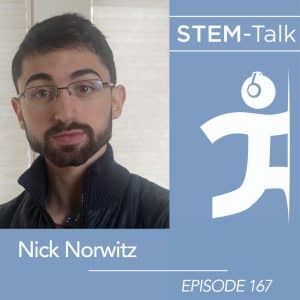
In the latest episode of STEM-Talk, available now where you listen to podcasts, Norwitz shares how what may have seemed to be an inevitable journey has evolved — and how it led him into research aimed at unlocking the potential of a ketogenic diet to improve metabolic health, mental health, and more.
It is a search that he began in part when his own injuries from running led him ultimately to more serious consideration of metabolic health.
Norwitz is an Oxford Ph.D., and a Harvard Medical School student who has drawn a following in part from his work with “lean mass hyper responders,” people who have high LDL cholesterol levels while on a ketogenic diet who are otherwise metabolically healthy.
The conversation includes:
- The impact that his own medical journey as a young man had on his path and on his belief that we must incorporate metabolic health in our healthcare system.
- Nick’s “Oreos vs. Statins” study which showed that for Lean Mass Hyper Responders, the introduction of a carb — in this case Oreo cookies — reduced LDL cholesterol far more effectively than statin therapy. His point was not to advocate Oreo cookies to manage cholesterol but rather to draw attention to the heterogeneity in responses.
- Nick’s paper on the Lipid Energy Model, which proposes a mechanistic explanation for the lean mass hyper responder phenotype.
And much more.
IHMC is a not-for-profit research institute of the Florida University System where researchers pioneer science and technology aimed at leveraging and extending human capabilities. IHMC researchers and staff collaborate extensively with the government, industry, and academia to help develop breakthrough technologies. IHMC research partners have included: DARPA, the National Science Foundation, NASA, Army, Navy, Air Force, National Institutes of Health, IBM, Microsoft, Honda, Boeing, Lockheed, and many others.
Robotics Open House inspired students to imagine themselves in STEM fields
Published 4.25.24
As a middle school teacher, Jen Reichwage believes that when it comes to the possibility of a career in science, for her students, seeing is believing.
“Students must be exposed to STEM-related professions,” she said. “If students cannot see what it means to be in (Science Technology Engineering and Math), they will likely not see themselves in a STEM field and not pursue one.”
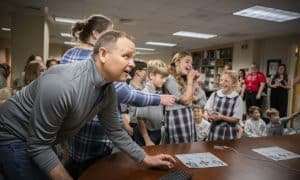
Senior Research Associate Larry Bunch and students at 2024 Open House. Photo Credit IHMC
That is why Reichwage led a field trip of her students to the April Open House at the Florida Institute for Human and Machine Cognition (IHMC). The event drew hundreds of people, including Reichwage’s students from Creative Learning Academy, as staff welcomed families, students, and the public for tours, walk-throughs, and inspiration on the Pensacola campus on South Alcaniz Street.
The family-friendly event encourages scientific discovery through hands-on activities, challenges, and demonstrations while providing the opportunity to learn. Visitors met IHMC researchers and saw first-hand their work in drones, robotics, virtual reality experiences, human performance research projects, data visualization, and more. The story is featured in the latest edition of the IHMC newsletter, available now.
Debbie Garland was another teacher who led a field trip to Open House, which coincides with National Robotics Week. Garland’s students are fourth-graders at Sacred Heart Cathedral School.
Her students learn about simple machines and coding in fourth grade, so open house offered a great hands-on learning opportunity for them to explore in a creative way. This was the fifth year that Garland brought her students to IHMC. She keeps bringing them back because it offers a unique hands-on learning experience that’s not found anywhere else.
“I feel that the students have a better idea about what sort of job opportunities might be available to those students that love science, robotics, and coding,” she said.
Rechwage said the biggest takeaway for her students was the chance to interact with researchers.
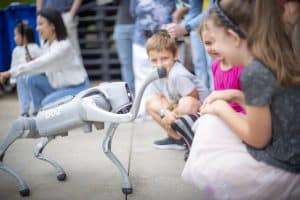
On April 11, 2024, IHMC hosted the annual Open House in conjunction with National Robotics Week. Photo Credit IHMC © All Rights Reserved
“Students were able to see different aspects of research that utilize technology in creative and innovative ways. They were able to test some of them and interact with others,” Reichwage said.
The Levin Center for IHMC Research — which houses the robotics lab — was one of the main draws of the event, but all of IHMC’s research disciplines were represented at Open House. Dozens of researchers in roboticists, engineering, cognitive science, and human performance, shared their work — and their love of their careers in science-related fields.
“The IHMC is a shining star for the Pensacola community and students were captivated by speaking to faculty and interacting with the exhibits,” Reichwage said.
National Robotics Week was established by Congress in 2010 and aims to bring together students, educators, and influencers who share a passion for robots and technology.
IHMC is a not-for-profit research institute of the Florida University System where researchers pioneer science and technology aimed at leveraging and extending human capabilities. IHMC researchers and staff collaborate extensively with the government, industry, and academia to help develop breakthrough technologies. IHMC research partners have included: DARPA, the National Science Foundation, NASA, Army, Navy, Air Force, National Institutes of Health, IBM, Microsoft, Honda, Boeing, Lockheed, and many others.
Intelligent cognitive assistant leveraging NLP to support those with dementia
Published 4.25.24
Researchers at the Florida Institute for Human and Machine Cognition are combining technology and healthcare to develop an application that uses natural language processing (NLP) to help dementia patients in real time with vocabulary recall.

Dr. Archna Bhatia
Dr. Archna Bhatia, leading the project team, is focused on harnessing NLP to help seniors with Alzheimer’s Disease and related dementias retrieve words in the course of daily life. The effort is being supported by funding from the Massachusetts AI and Technology Center, a member of the a2Collective, which represents the Artificial Intelligence and Technology Collaboratories for Aging Research (AITC). The AITC program is funded by the National Institute on Aging (NIA), part of the National Institutes of Health.
The project’s goal is to develop an assistant that learns from the user and builds a personalized database utilizing natural language processing that can help users in real time by retrieving difficult words, and ultimately could identify the areas of memory where a person is having more difficulty. It could then provide feedback to strengthen the connections in areas where they are weaker.
The IHMC team working on the app development includes Dr. Bhatia, Dr. Peter Pirolli, Roger Carff and William de Beaumont, and collaborates with esteemed colleagues, Dr. George Sperling from University of California Irvine (UCI), and Dr. Misha Pavel from Northeastern University, alongside a research assistant, Lingyu Gan, from UCI. The app is now in development.
It will identify users’ associative networks, the intricate web of connections woven between the words in each person’s memory, based on the way that person uses them. It then will tailor the feedback it offers “because each individual connects words differently based on their own knowledge and past experiences,” Bhatia said.
By way of example, Bhatia notes that in the brain, the names of all of a person’s neighbors are built in one associative network. The list of all of your medications, instructions from your healthcare providers are built in another. There could be, and there would be connections in between these different sub regions as well, but all of those connections are highly individualized.
Even in the typical pattern of aging, “these connections become weaker and that’s when we start to forget,” Bhatia said. Fatigue, distraction, among other things also play a role in weakening these connections and negatively impact the processing capabilities of these systems.
However, when neurodegenerative disorders and dementias are present, these disorders add yet another layer of disruption to the capacity of these systems to recall the words and phrases we may need to communicate.
This application, it is hoped, will keep collecting data from users as they input it. For example, whenever a user remembers something, they could note it with the assistant at a time when that memory and connection are strong and at the forefront.
Each time the user asks the assistant about something, behind the scenes, the assistant is learning about the associative networks that user relies upon. Ultimately, it could spot patterns in the queries from the user. For example, if a person is increasingly asking questions about medications, or about the names of people, the assistant could send that user games, puzzles or other stimulations to strengthen the connections that are weakening.
A longer-term goal Bhatia said, is that the database built across all of the app’s users could provide insights into what regions of the associative networks are impacted more often as Alzheimer’s disease progresses. Such an insight could help support targeted therapies and further research into these areas.
The Centers for Disease Control and Prevention notes that in 2020, nearly 5.8 million people are living with Alzheimer’s and related dementia. That figure is estimated to reach 14 million people by 2060. The prevalence of dementia-related disorders is a growing challenge for those diagnosed with it and their friends and family member who care for them.
IHMC is a not-for-profit research institute of the Florida University System where researchers pioneer science and technology aimed at leveraging and extending human capabilities. IHMC researchers and staff collaborate extensively with the government, industry, and academia to help develop breakthrough technologies. IHMC research partners have included: DARPA, the National Science Foundation, NASA, Army, Navy, Air Force, National Institutes of Health, IBM, Microsoft, Honda, Boeing, Lockheed, and many others.


